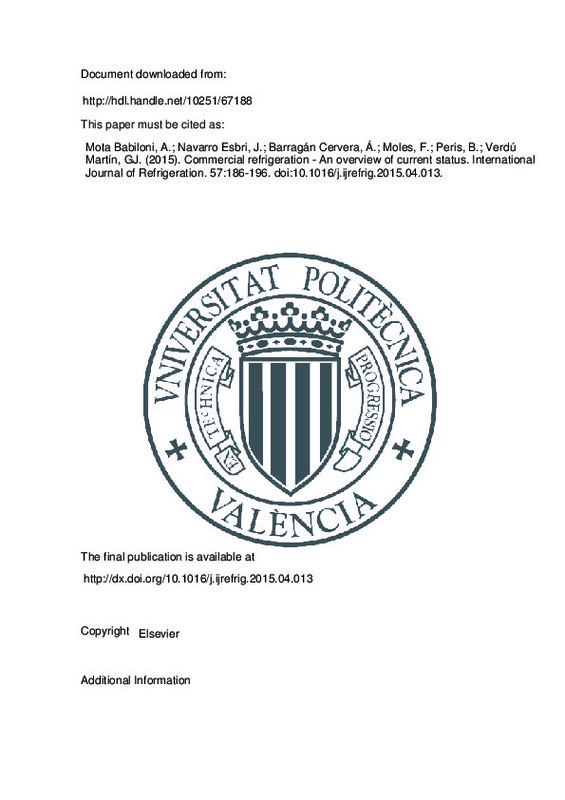JavaScript is disabled for your browser. Some features of this site may not work without it.
Buscar en RiuNet
Listar
Mi cuenta
Estadísticas
Ayuda RiuNet
Admin. UPV
Commercial refrigeration - An overview of current status
Mostrar el registro sencillo del ítem
Ficheros en el ítem
| dc.contributor.author | Mota Babiloni, Adrián
|
es_ES |
| dc.contributor.author | Navarro Esbrí, Joaquín
|
es_ES |
| dc.contributor.author | Barragán Cervera, Ángel
|
es_ES |
| dc.contributor.author | Moles, Francisco
|
es_ES |
| dc.contributor.author | Peris, Bernardo
|
es_ES |
| dc.contributor.author | Verdú Martín, Gumersindo Jesús
|
es_ES |
| dc.date.accessioned | 2016-07-06T07:24:37Z | |
| dc.date.available | 2016-07-06T07:24:37Z | |
| dc.date.issued | 2015-09 | |
| dc.identifier.issn | 0140-7007 | |
| dc.identifier.uri | http://hdl.handle.net/10251/67188 | |
| dc.description.abstract | [EN] Commercial Refrigeration comprises food freezing and conservation in retail stores and supermarkets, so, it is one of the most relevant energy consumption sectors, and its relevance is increasing. This paper reviews the most recent developments in commercial refrigeration available in literature and presents a good amount of results provided these systems, covering some advantages and disadvantages in systems and working fluids. Latest researches are focused on energy savings to reduce CO2 indirect emissions due to the burning of fossil fuels. They are focused on system modifications (as dedicated subcooling or the implementation of ejectors), trigeneration technologies (electrical, heating and cooling demand) and better evaporation conditions control. Motivated by latest GWP regulations that are intended to reduce high GWP HFC emissions; R404A and R507 are going to phase out. Besides hydrocarbons and HFO, CO2 appears as one of the most promising HFC replacements because its low contribution to global warming and high efficiencies when used in transcritical and low-stage of cascade systems. | es_ES |
| dc.description.sponsorship | The authors thankfully acknowledge "Ministerio de Educacion, Cultura y Deporte" for supporting this work through "Becas y Contratos de Formacion de Profesorado Universitario del Programa Nacional de Formacion de Recursos Humanos de Investigacion del ejercicio 2012". | |
| dc.language | Inglés | es_ES |
| dc.publisher | Elsevier | es_ES |
| dc.relation.ispartof | International Journal of Refrigeration | es_ES |
| dc.rights | Reserva de todos los derechos | es_ES |
| dc.subject | Commercial Refrigeration | es_ES |
| dc.subject | Supermarket | es_ES |
| dc.subject | Energy Saving | es_ES |
| dc.subject | HFC replacement | es_ES |
| dc.subject | Control | es_ES |
| dc.subject | Review. | es_ES |
| dc.subject.classification | INGENIERIA NUCLEAR | es_ES |
| dc.title | Commercial refrigeration - An overview of current status | es_ES |
| dc.type | Artículo | es_ES |
| dc.identifier.doi | 10.1016/j.ijrefrig.2015.04.013 | |
| dc.rights.accessRights | Abierto | es_ES |
| dc.contributor.affiliation | Universitat Politècnica de València. Departamento de Ingeniería Química y Nuclear - Departament d'Enginyeria Química i Nuclear | es_ES |
| dc.contributor.affiliation | Universitat Politècnica de València. Departamento de Termodinámica Aplicada - Departament de Termodinàmica Aplicada | es_ES |
| dc.contributor.affiliation | Universitat Politècnica de València. Instituto de Seguridad Industrial, Radiofísica y Medioambiental - Institut de Seguretat Industrial, Radiofísica i Mediambiental | es_ES |
| dc.description.bibliographicCitation | Mota Babiloni, A.; Navarro Esbri, J.; Barragán Cervera, Á.; Moles, F.; Peris, B.; Verdú Martín, GJ. (2015). Commercial refrigeration - An overview of current status. International Journal of Refrigeration. 57:186-196. doi:10.1016/j.ijrefrig.2015.04.013 | es_ES |
| dc.description.accrualMethod | S | es_ES |
| dc.relation.publisherversion | http://dx.doi.org/10.1016/j.ijrefrig.2015.04.013 | es_ES |
| dc.description.upvformatpinicio | 186 | es_ES |
| dc.description.upvformatpfin | 196 | es_ES |
| dc.type.version | info:eu-repo/semantics/publishedVersion | es_ES |
| dc.description.volume | 57 | es_ES |
| dc.relation.senia | 290723 | es_ES |
| dc.identifier.eissn | 1879-2081 | |
| dc.contributor.funder | Ministerio de Educación, Cultura y Deporte |







![[Cerrado]](/themes/UPV/images/candado.png)

